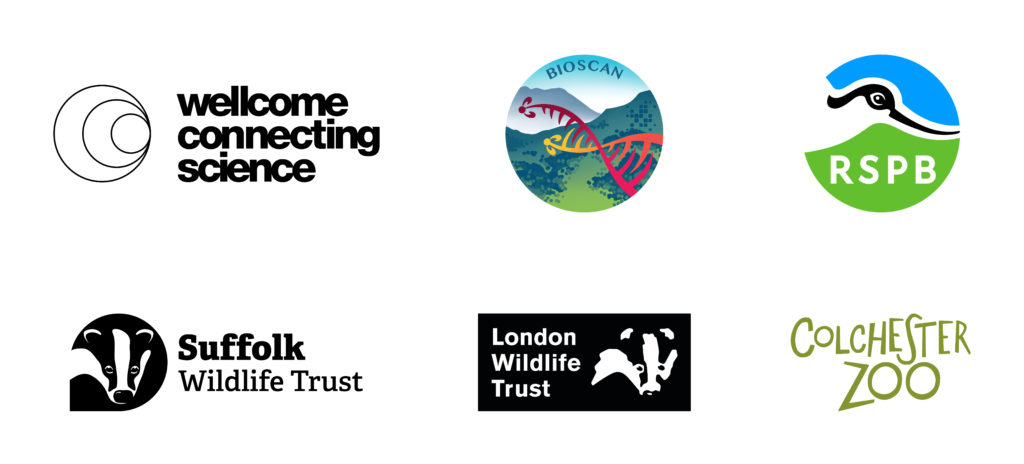We are excited to announce the launch of Buzz Map, a collaboration with five nature sites across East Anglia, connecting with communities to map flying insect populations in their local area using cutting-edge DNA science.
As part of the initial phase of Buzz Map, Wellcome Connecting Science have partnered with Colchester Zoo, Suffolk Wildlife Trust Carlton Marshes, Suffolk Wildlife Trust Lackford Lakes, RSPB Rainham Marshes and London Wildlife Trust Walthamstow Wetlands to launch this community science initiative.
Across these sites, volunteers and local communities will be able to engage first hand with cutting-edge DNA conservation science and learn more about how DNA can be used to understand our local insect populations and biodiversity.
Throughout the course of Buzz Map there will be lots of activities and events at each of the sites for you to get involved in. To keep up-to-date with the latest Buzz Map events and activities, as well as other Wellcome Connecting Science events, why not sign up to our events newsletter.
BIOSCAN
As part of this initiative, each of the five sites will be a part of the national BIOSCAN research project, led by the Wellcome Sanger Institute.
The BIOSCAN project aims to study the genetic diversity of 1,000,000 flying insects from all across the UK. Insects from 100 sites will be collected on a monthly basis and then analysed at the Wellcome Sanger Institute using a process called DNA barcoding.
DNA barcodes are short unique segments of DNA within a genome that can be used to identify different species, much like how barcodes are used to identify different shopping products. This method of identification is relatively fast and cheap. The resulting DNA sequence data will provide a baseline characterisation of insect species diversity over space and time and thus form a much needed resource for DNA-based biomonitoring and conservation in the UK.

About our sites
Have a read below for more information about each of our sites and their habitats. Make sure to pay them a visit to find out what they are up to as part of Buzz Map!
Colchester Zoo
Colchester Zoo is home to over 160 species set in 60 acres of parkland and lakes!
As you navigate your way around Colchester Zoo, you’ll visit many different habitats and see animals from around the world, from the humid habitat of our Komodo dragons to our very own Africa plain, home to White rhino, giraffes, ostrich, zebra and kudu! Your wild adventure awaits.
RSPB, Rainham Marshes
Rainham Marshes protects 411 hectares of the Thames Estuary, an idyllic wildlife haven just a stone’s throw from London. It is a designated Site of Special Scientific Interest (SSSI), encompassing reedbed, wet grassland, open freshwater, woodland and saltmarsh habitats. The marshes are home to nationally-significant populations of water vole, breeding waders, wintering wildfowl and rare invertebrates.
Beyond its significance as protected wildlife habitat, the site is also a busy visitor destination on the doorstep of London and South Essex and a key environmental education provider for local school groups.
London Wildlife Trust, Walthamstow Wetlands
Walthamstow Wetlands is Europe’s largest urban wetland, a partnership between Thames Water, London Borough of Waltham Forest, and London Wildlife Trust. This 221 hectare nature reserve comprises 10 reservoirs which provide drinking water to London and is a nationally important breeding and overwintering habitat for many water birds and other wildlife.
Suffolk Wildlife Trust, Carlton Marshes
Carlton Marshes is situated in the Waveney Valley at the southern tip of the Norfolk Broads National Park. It comprises a jigsaw of grazing marsh, fens, peat pools, short fen meadow, tall fen (called ‘tall litter fen’), dykes, pools and scrub. Mostly man-made, these habitats have developed over hundreds of years of traditional management and now host specialised wildlife.
The flower studded marshes drained by a system of dykes and grazed by cattle in summer creates a paradise for marshland birds and birds of prey including hobby and marsh harrier.
Suffolk Wildlife Trust, Lackford Lakes
Lackford Lakes is a wildlife oasis with a landscape of lakes, reeds, meadow and woodland. There is wildlife in close-up all year round with iridescent kingfisher, dazzling dragonflies and colourful ducks. Lackford Lakes has a visitor centre and reserve is free to visit all year round.
Get involved
If you live in the following local authorities; West Suffolk, East Suffolk, Tendring, Thurrock and Waltham Forest, and would like to hear about ways you can help Buzz Map, please email engage@wellcomeconnectingscience.org
